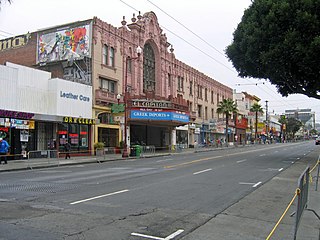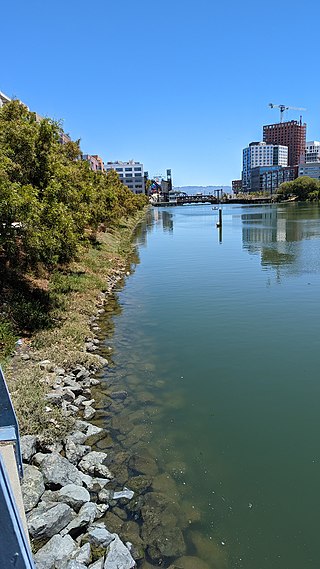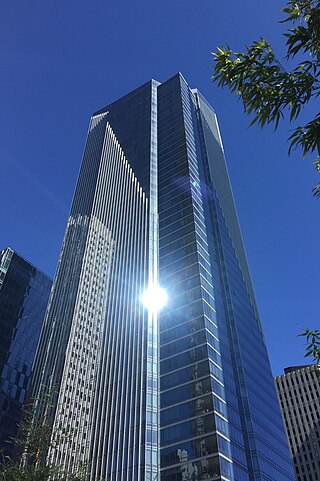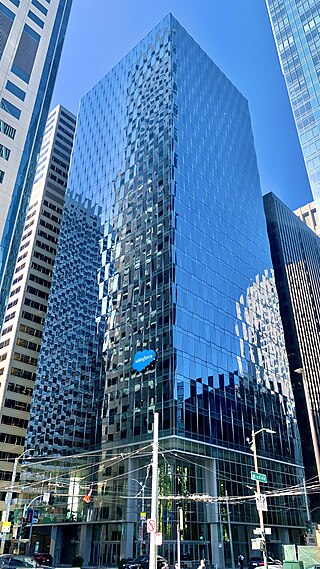
South of Market (SoMa) is a neighborhood in San Francisco, California, situated just south of Market Street. It contains several sub-neighborhoods including South Beach, Yerba Buena, and Rincon Hill.

The San Francisco Transbay Terminal was a transportation complex in San Francisco, California, United States, roughly in the center of the rectangle bounded north–south by Mission Street and Howard Street, and east–west by Beale Street and 2nd Street in the South of Market area of the city. It opened on January 14, 1939 as a train station and was converted into a bus depot in 1959. The terminal mainly served San Francisco's downtown and Financial District, as transportation from surrounding communities of the Bay Area terminated there such as: Golden Gate Transit buses from Marin County, AC Transit buses from the East Bay, and SamTrans buses from San Mateo County. Long-distance buses from beyond the Bay Area such as Greyhound and Amtrak also served the terminal. Several bus lines of the San Francisco Municipal Railway connected with the terminal.

Mission Street is a north-south arterial thoroughfare in Daly City and San Francisco, California that runs from Daly City's southern border to San Francisco's northeast waterfront. The street and San Francisco's Mission District through which it runs were named for the Spanish Mission Dolores, several blocks away from the modern route. Only the southern half is historically part of El Camino Real, which connected the missions. Part of Mission Street in Daly City is signed as part of State Route 82.

César Pelli was an Argentine-American architect who designed some of the world's tallest buildings and other major urban landmarks. Two of his most notable buildings are the Petronas Towers in Kuala Lumpur and the World Financial Center in New York City. The American Institute of Architects named him one of the ten most influential living American architects in 1991 and awarded him the AIA Gold Medal in 1995. In 2008, the Council on Tall Buildings and Urban Habitat presented him with The Lynn S. Beedle Lifetime Achievement Award.

Mission Bay is a 303-acre (123 ha) neighborhood on the east side of San Francisco, California. It is bordered by China Basin to the north, Dogpatch to the south, and San Francisco Bay to the east. Originally an industrial district, it underwent development fueled by the construction of the UCSF Mission Bay campus, and is currently in the final stages of development and construction. It is the site of the Chase Center.

Rincon Center is a complex of shops, restaurants, offices, and apartments in the South of Market neighborhood of Downtown San Francisco, California. It includes two buildings, one of which is the former Rincon Annex post office building, completed in 1940. Rincon Center occupies an entire city block near the Embarcadero, bounded by Mission, Howard, Spear, and Steuart Streets.

301 Mission Street is a high-rise residential building in the South of Market district of downtown San Francisco. A mixed-use, primarily residential high rise, it is the tallest residential building and the 6th-tallest overall in San Francisco. In May 2016, residents were informed the main tower was both sinking and tilting, resulting in several lawsuits concerning repair costs and whether the tilt had been withheld from buyers. The building is being modified in an effort to stop its sinking.

The JPMorgan Chase Building is an office building in San Francisco, California, 560-584 Mission Street, on the border between South of Market and the Financial District. Designed by architect César Pelli, the building stands 128.02 m (420.0 ft) and has about 655,000 square feet (60,900 m2) of office space. It also has two levels of underground parking and a large plaza. About 400,000 sq ft (37,000 m2) of the building is leased to the major tenant JPMorgan Chase. This is one of many new highrise projects completed or under construction on Mission Street since 2000.

San Francisco 4th and King Street station, or Caltrain Depot is a train station in the SoMa district of San Francisco, California. It is presently the northern terminus of the Caltrain commuter rail line serving the San Francisco Peninsula and Santa Clara Valley. It is also the eastern terminus of the N Judah and E Embarcadero, as well as a stop along the T Third Street of the Muni network. The station is additionally the projected terminus for the first phase of the California High-Speed Rail project and a station once Phase 2 is completed.

181 Fremont is an 803-foot (245 m) mixed-use skyscraper in the South of Market District of San Francisco, California. The building, designed by Heller Manus Architects, is located adjacent to the Transbay Transit Center and 199 Fremont Street developments. 181 Fremont is owned and operated by Jay Paul Company. Jay Paul Company was the sole owner and developer of the project. The entire office portion of the building was leased to Facebook to house its San Francisco office and Instagram division.
The Palace Hotel Residential Tower was a residential skyscraper proposed in 2006, which was to have been built at the corner of Jessie & Annie Streets in the South of Market district of San Francisco, California. At 204 m (669 ft) and 60 stories, it would have been the tallest residential building in the city, and the tallest South of Market. Had it been constructed, prior to the Financial crisis of 2007–2008, the tower would have replaced an annex of the Palace Hotel.

Salesforce East is a 30-story skyscraper in the South of Market district of San Francisco, California.

The Transbay Transit Center is a transit station in downtown San Francisco. It serves as the primary bus terminal—and potentially as a future rail terminal—for the San Francisco Bay Area. The centerpiece of the San Francisco Transbay development, the construction is governed by the Transbay Joint Powers Authority (TJPA). The 1,430-foot-long (440 m) building is located one block south-east of Market Street, a primary commercial and transportation artery in San Francisco.

Salesforce Tower, formerly known as Transbay Tower, is a 61-story skyscraper at 415 Mission Street, between First and Fremont Street, in the South of Market district of downtown San Francisco. Its main tenant is Salesforce, a cloud-based software company. The building is 1,070 feet (326 m) tall, with a top roof height of 970 feet (296 m). Designed by César Pelli and developed by Hines Interests Limited Partnership and Boston Properties, it was the last building designed by Pelli to be completed in his lifetime. As of 2018, Salesforce Tower is the tallest building in San Francisco and the second-tallest building both in California and west of the Mississippi River after the 1,100 feet (335 m) Wilshire Grand Center in Los Angeles.
Oceanwide Center is a mixed-use skyscraper complex on hold in the South of Market neighborhood of San Francisco, California, consisting of two towers.

Park Tower at Transbay is a 43-story, 605-foot (184 m) office skyscraper in San Francisco, California. The tower is located on Block 5 of the San Francisco Transbay development plan at the corner of Beale and Howard Streets, near the Transbay Transit Center. The tower contains 743,000 square feet (69,000 m2) of office space. The entire office space has been leased by Facebook.
The Downtown Rail Extension (DTX) is a planned second phase of the San Francisco Transbay Transit Center (TTC). When complete, it will extend the Caltrain Peninsula Corridor commuter rail line from its current northern terminus at 4th and King via a 1.3 mi (2.1 km) tunnel. The new terminus will be near the Financial District and will provide intermodal connections to BART, Muni, Transbay AC Transit buses, and long-distance buses. In addition, the California High Speed Rail Authority (CHSRA) plans to use DTX and the Caltrain-owned Peninsula Corridor for service on the CHSRA San Francisco–San Jose segment. Because DTX uses a long tunnel, current diesel locomotives are not suitable and the Caltrain Modernization Project (CalMod), which includes electrification of the line and acquisition of electrified rolling stock, is a prerequisite.

MIRA is a 39-story, 422-foot (129 m) residential skyscraper under construction at 280 Spear Street in San Francisco, California.

















